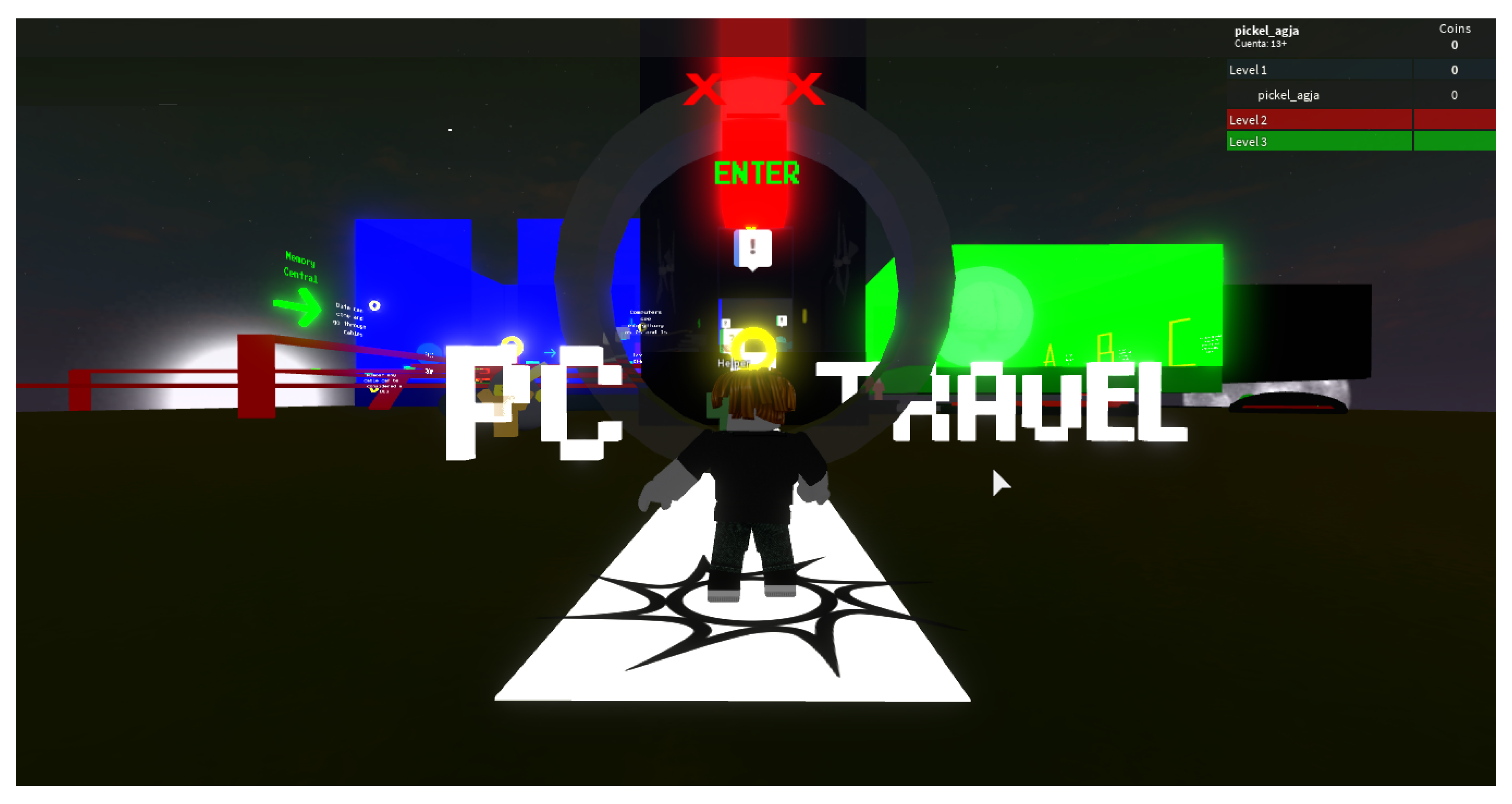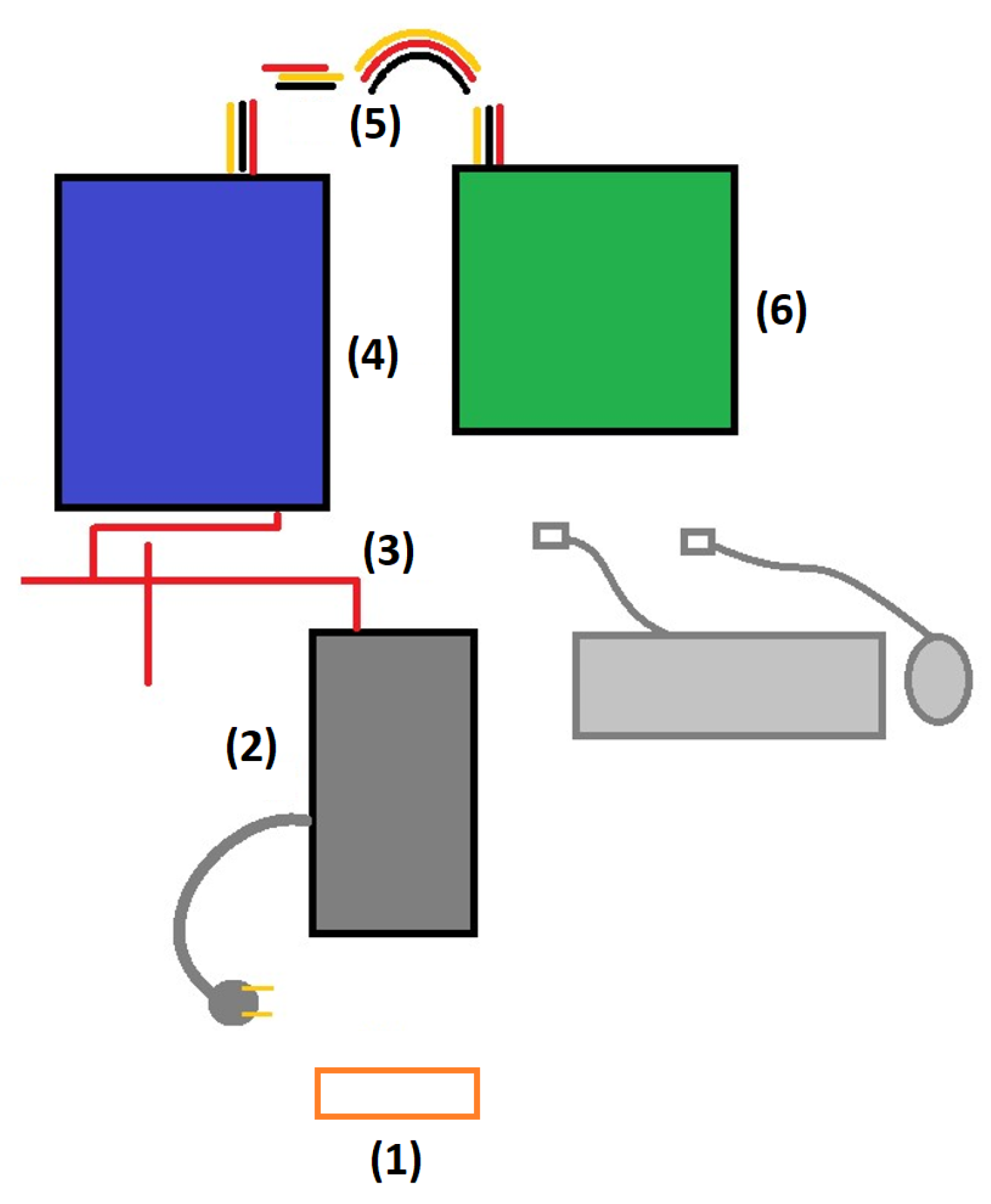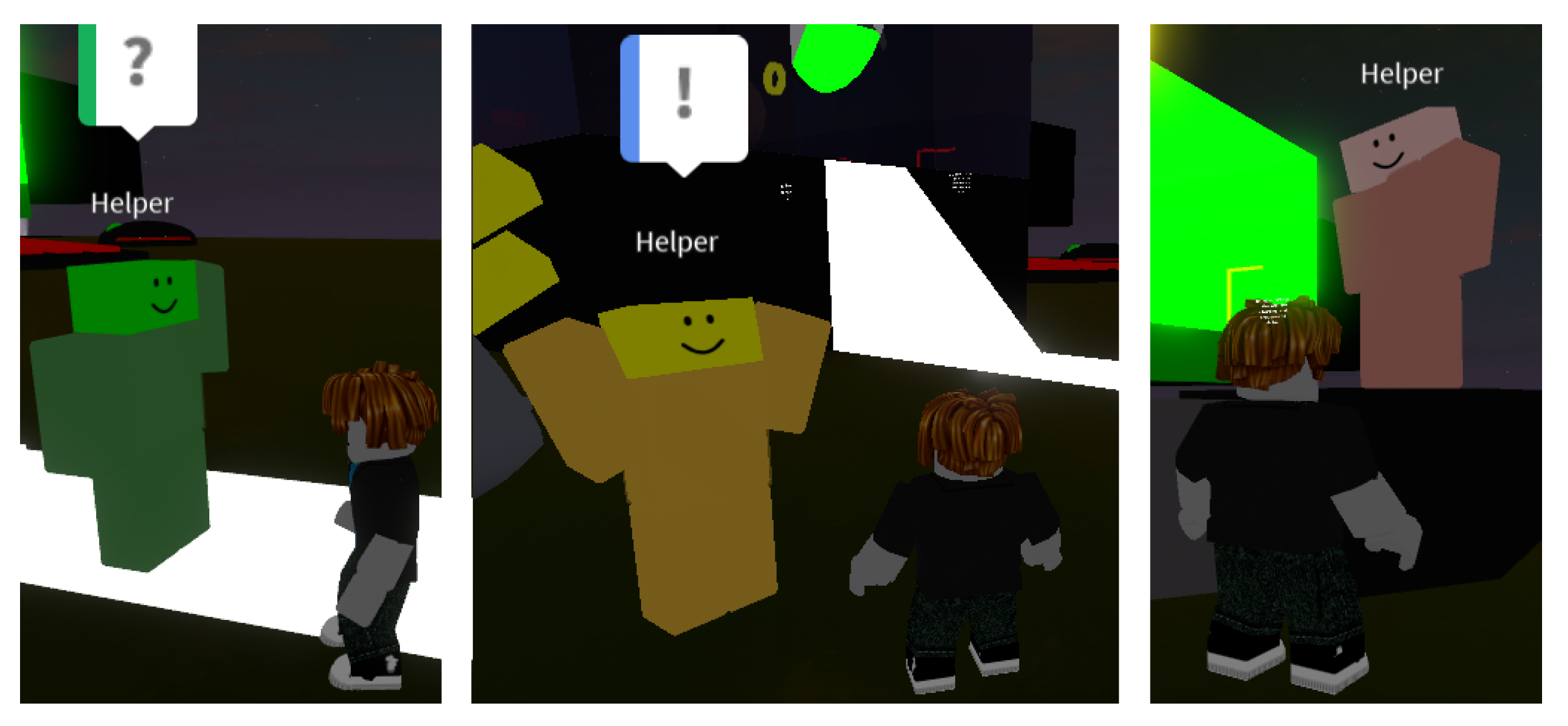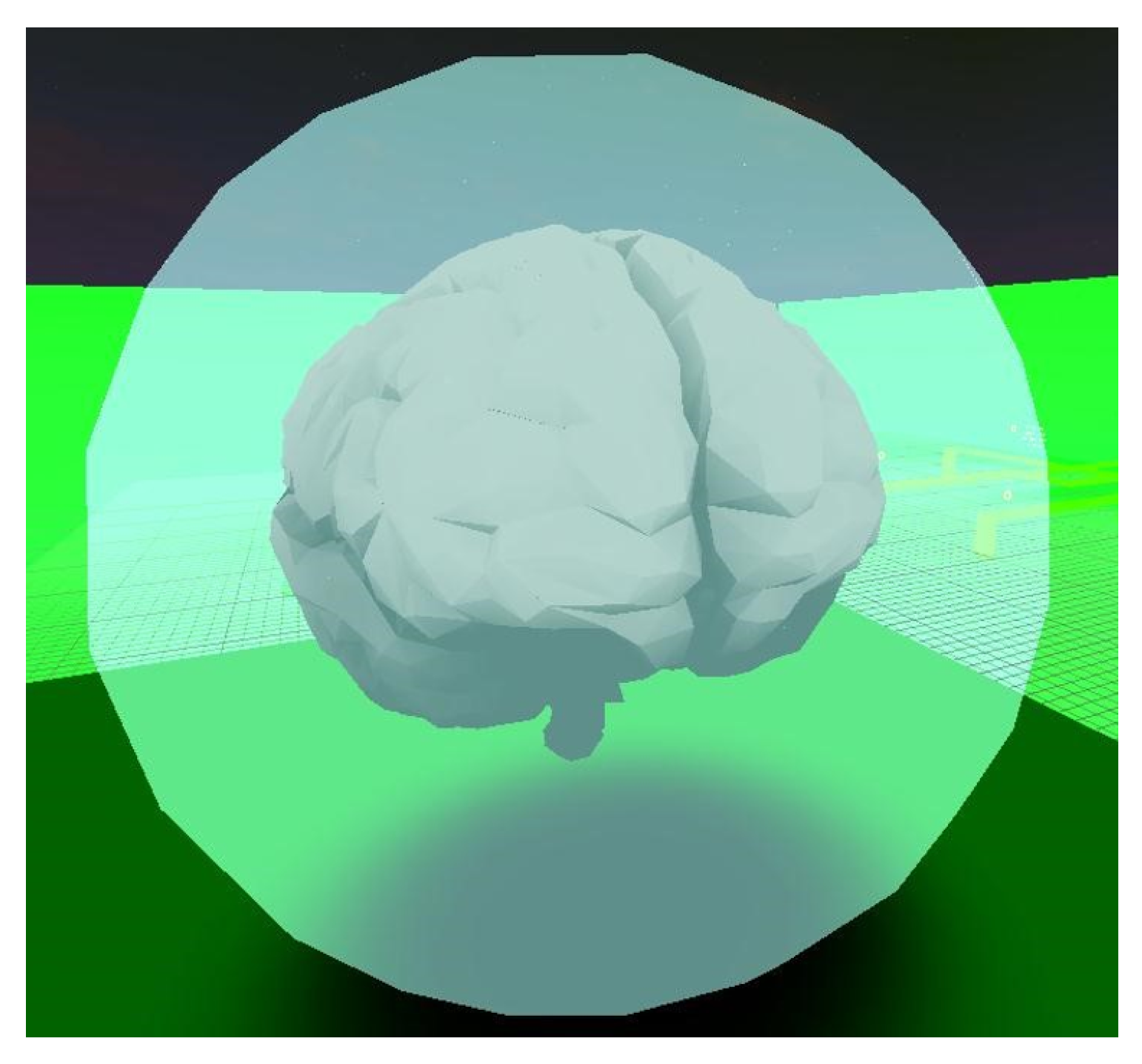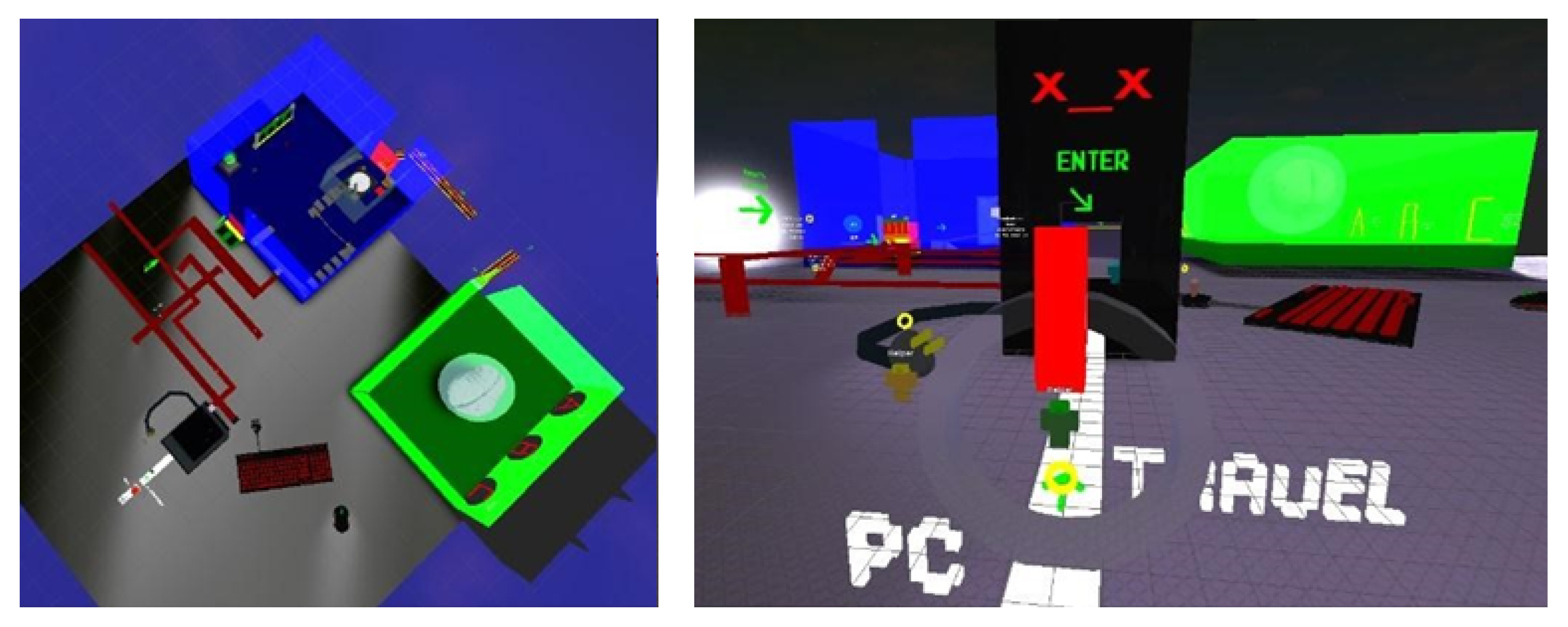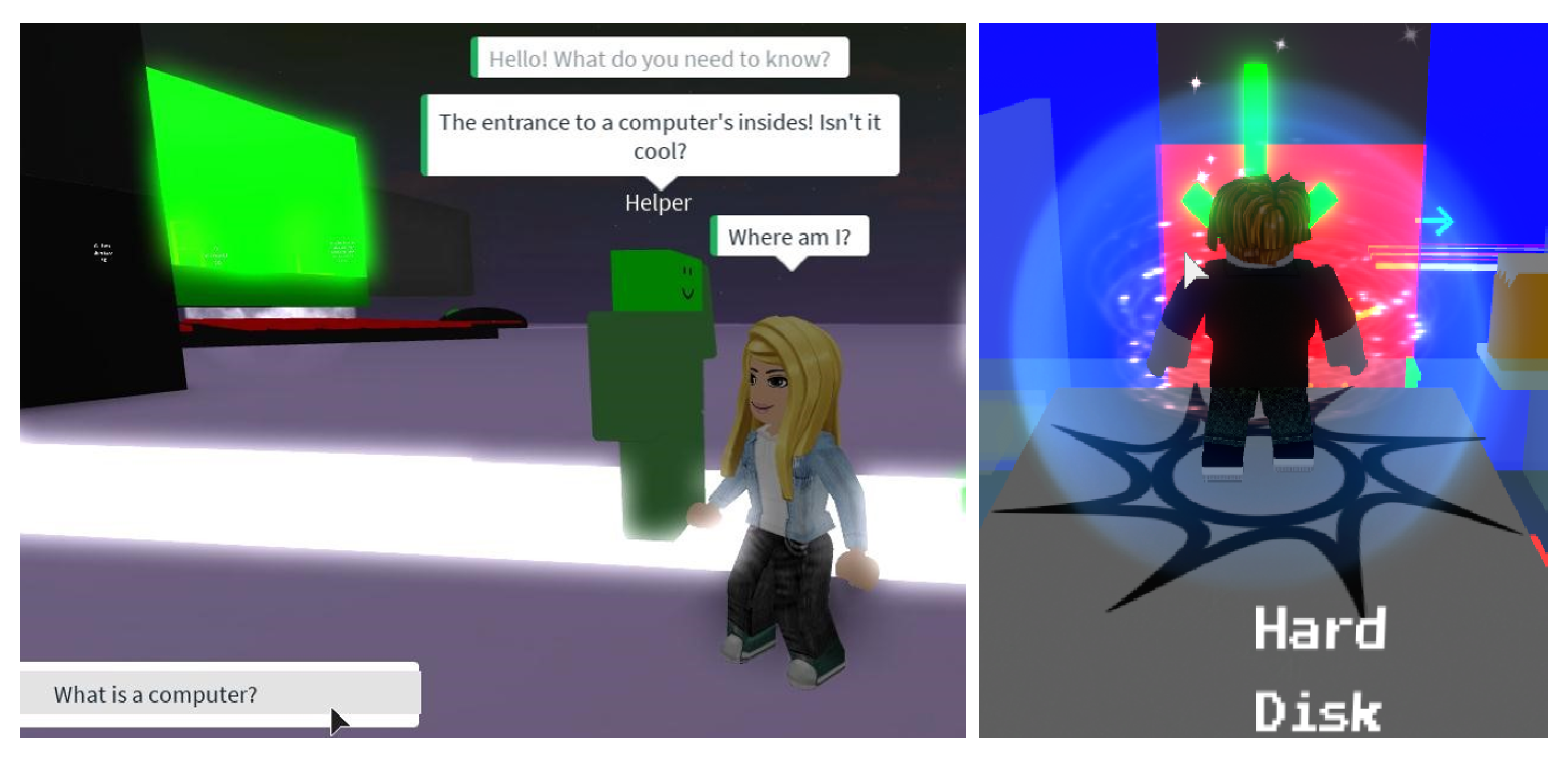A Method to Develop Accessible Online Serious Games for People with Disabilities: A Case Study
Abstract
1. Introduction
2. Background
2.1. Visual Disabilities
- Normal vision.
- Moderate visual disability.
- Severe visual disability.
- Blindness.
2.2. Motor Disabilities
- Structure of head and neck region.
- Structure of shoulder region.
- Structure of upper extremity.
- Structure of pelvic region.
- Structure of lower extremity.
- Structure of trunk.
2.3. Hearing Disabilities
- Slight/mild hearing loss (26–40 dB).
- Moderate hearing loss (41–60 dB).
- Severe hearing loss (61–80 dB).
- Profound hearing loss (over 81 dB).
2.4. Cognitive Disabilities
3. Method and Materials
- 1.
- General InformationThis section contains the general information of the serious game:
- Game title: A name for the serious game.
- Intended game systems: The platforms on which the serious game could be played (mobile, console, pc, etc.).
- Systems requirements: The minimum requirements that are necessary to execute the serious game. This includes the Internet speed connection.
- Target age of players: The profile and age of the recommended user for the serious game.
- 2.
- Game Outline
- Game story summary: Describe a review of the story that the serious game will tell. It should cover the details necessary to understand the serious game through precise and short wording.
- Game Flow: Briefly describe the flow of the game’s action in the context of the locations the player will be in. The flow of the game should describe information such as the challenges that will be presented, the rewards for solving challenges, the gameplay in the story and the conditions to win the game.
- 3.
- CharactersAt this point, a detailed description of the characteristics of the serious game characters should be made. The following questions can help to define the characters:
- How will the characters look?
- What skills will the characters have?
- How will the characters relate to the story of the game?
The answers to these questions should include all relevant parameters needed for the implementation of the characters in the serious game. - 4.
- ObjectsThe serious game could contains several decorative and interactive objects. In this section, it is important to describe each object that the developer will include in the serious game and define its features.
- 5.
- GameplayThis section should cover details that will be important for readers to understand what technological requirements will be necessary to produce the serious game (hardware and software). Each platform defined their controls and buttons for mobility or functions.
- 6.
- Gameplay MechanicsAccording to Rogers [52], it is considered a mechanic to the items or elements with which a player interacts to create objects or help each other to pass challenges.
- 7.
- EnemiesIn many video games, enemies are considered the villains who seek to defeat the protagonist of the game so that he does not achieve victory. However, challenges or situations that hinder the advancement or successful end of a video game can also be regarded as enemies.
- 8.
- MultiplayerThe multiplayer feature allows the user to generate teamwork skills and in the educational field it can develop collaborative learning skills. One of the advantages of an online serious game is that the multiplayer feature can transcend borders and generate intercultural ties.
- 9.
- MonetizationThis characteristic may change depending on the approach to serious gaming. A large number of online video games are free and profit in other ways such as through advertising. However, there is always the alternative of proposing a serious video game that includes payments for some of its functionalities.
- 10.
- Video Game AccessibilityAccessibility in video games has become a challenge for software developers. Some accessibility guidelines (G) state that serious games should incorporated according to each disability are listed in Table 1 [53]. It can be seen how each guideline can support one or more groups of disabilities: Visual (V), Motor (M), Cognitive (C) or Hearing (H).Each of these accessibility guidelines are described in more detail below:
- G1. Adequate distributed virtual controls. A very useful feature for people with limited mobility and vision. It is recommended that the video game allows for reconfiguring the controls to suit the player’s needs. For example, a user who can only use one hand may prefer to bring the controls closer to restrict movement in a smaller area. This feature can make a difference in the experience of a video game.
- G2. Sensitivity sliders. There are some disabled players who have little strength, dexterity, mobility or involuntary movements. The ability to set the level of sensitivity allows players to transfer small movements of the controller to large actions on the screen or larger movements on the contrary will lead to more precise game actions. This feature translates into less effort on the part of the player.
- G3. Controls compatible with assistive technology. Players with motor disabilities have specific requirements that are commonly translated into the use of specialized hardware. Systems such as flicker detectors, micro-switches that are assigned to buttons or keystrokes/mouse or eye tracking are often used. Adapting to video games for simple movements that can be interpreted by this type of hardware is an important feature to consider.
- G4. Adjustable sensitivity/error tolerance. There is no sensitivity level for all video games or players. In addition to personal preferences, some types of players have a restricted range of motion and therefore require very high sensitivity. On the other hand, some players have difficulty with accuracy so they require very little sensitivity and even more so when using alternative input devices.
- G5. Use simple language. Using a very specific language may cause the player to not understand the instructions to continue with a video game. For this reason, it is recommended to use a language that allows one to tell a simple and easy-to-follow story and set aside terms that most players cannot understand.
- G6. Voice or text repetition. It is advisable to incorporate the possibility of repeating voice messages or texts within a video game. The repetition feature is used by players when dialogues or texts are difficult to follow.
- G7. Appropriate words-per-minute. It is very important to transmit information through subtitles, especially for deaf people. Thus, the number of words per minute must be taken into account—for example, considering the TV industry guidelines [54]. Taking into account an adequate number of words allows players with different disabilities to read the subtitles so that they can fully understand the conversation or instruction.
- G8. Subtitles. Subtitles, especially for people with hearing disabilities, have become an essential feature. The incorporation of subtitles in video games allows players to have a more pleasant experience in the history of the video game, as well as allowing them to receive instructions in a clearer way.
- G9. Pause while text is being read. In a video game, it is helpful to pause the execution of a text. This feature gives players more time to read the instructions or dialogues of the video game.
- G10. Save points. Some video game players may find it difficult to remain seated for long periods of time. This occurs in some cases due to conditions of diseases, such as muscular dystrophy, multiple sclerosis and/or other neurological disorders. For this reason it becomes important to incorporate in the video game Saving Points in order that the player can save his progress and resume it when necessary.
- G11. Use explicit visual rewards. People with different learning disabilities require receiving explicit visual or auditory rewards, either for animation or video, as motivation to keep their attention in the video game. This feature will allow the player’s skills to increase and motivate them to reach new video game challenges.
- G12. No timing essential to gameplay. There are video games in which time requirements are necessary but in others it is not. One recommendation is to avoid time requirements if they are not strictly necessary. This will allow players to enjoy the video game more casually and in a calm manner.
- G13. Simple-to-difficult progression. Allow for the modification of degrees of difficulty to a greater extent than usual in games. For example, for real time strategy games, add a speed slider or allow the game to change to a turn mode.
- G14. Visual indication of who is currently speaking. Conversations in a video game can be difficult to follow when the player cannot distinguish between different accents and voices. A different color for each character, placing the text on the side of the screen where the character is, naming him or even representing his face, are useful for a person with a disability, so they can recognize the character that is speaking at that moment.
- G15. Controls reminder during gameplay. Complex controls can sometimes be difficult for any player to remember and much more for those with memory problems. For this reason, it is helpful that players can access reminders of controls and their specific actions in the development of the history of the video game.
- G16. Simple controls. The controls are simple and quite intuitive. Even the default control settings should follow how most games work, so people with experience in video games will find it even easier.
- G17. Challenges repetitions. On many occasions the players do not have enough ability to overcome the different challenges of video games. This occurs more frequently in the case of people with disabilities. For this reason it is important to allow the challenges to be repeated countless times or at least the video game should enable this option to be activated. The challenges do not require extreme accuracy in order to be overcome by the players and, if they fail, they can be repeated.
- G18. No multiple actions required. Players with motor disabilities often have difficulty pressing the controls of a video game. For this reason it is important to avoid executing several actions that involve pressing several buttons at the same time. In the case of the video game, the player must only advance and jump at the same time for certain obstacles, but no challenge should require the user to press more than two buttons at the same time.
- G19. No repetitive mechanics. For many players, especially those with motor disabilities, it is often complex to perform repetitive actions during the development of the video game. Thus, it is recommended to avoid the use of repetitive mechanics such as pressing quickly and many times a button.
- G20. Easy execution. Young children and people with cognitive disabilities often have problems in video games in which many configurations or steps are required to start playing. For this reason it is important that the start of a video game is as simple as possible avoiding navigation through multiple menus.
- G21. High contrast. People with low vision commonly have trouble appreciating the scenes of a video game. It is for this reason that the ability to alter the contrast and other graphic features of the video game, such as lighting, may be helpful for the scenes to be displayed more clearly for the player.
4. Case Study
4.1. Development
- 1.
- General Information
- Game title: PC TRAVEL.
- Intended game systems: Roblox platform allows the following systems:
- –
- Android OS from version 4.0.3 onwards.
- –
- iOS from version 8 onwards.
- –
- Amazon Fire OS, 3rd generation onwards, except Amazon Fire HD 2013.
- –
- PC from Windows XP OS onwards.
- –
- MAC from version 10.7(Lion) onwards.
- –
- Chrome OS from version 53 onwards.
It is important to indicate that Roblox is compatible with virtual reality systems, such as Oculus Rift and HTC Vive. - Systems requirements: The minimum requirements that a computer requires to run Roblox are:
- –
- Graphics card that supports DirectX 9 and Shader Model 2.0.
- –
- Recent processor, released in 2005 or later, with a speed of 1.6GHz or better
- –
- 1 GB of RAM minimum
- –
- 10 MB of storage space at least
Finally, the required Internet speed is a minimum of 4-8 Mbps for the connection and also 3G or higher networks in the case of mobile devices. - Target age of players: The online serious game is recommended for 6-year-old individuals and those that are older. The game is educational and informative, so it has a large amount of text since the information given is based on dialogues. For this reason it is recommended that the player knows the English language for a better experience.
- 2.
- Game Outline
- Game story summary: The game is developed inside a computer and it has several elements corresponding to the architecture of a computer. In each element there are some characters called “helpers” that share information with the player. The player must go through the different elements of the computer solving challenges and answering questions that evaluate the knowledge that is acquired in the online serious game. Figure 1 shows a screen of the online serious game outline.Figure 1. PC TRAVEL Initial Screen.
- Game Flow:Figure 2 represents a map detailing the stages and order of the route that will be applied to the game:Figure 2. Serious Game Map and Stages: (1) Start (2) PC Chasis (3) BUS (4) Memory Center (5) Connector Bridge (6) Processing Center.Figure 2. Serious Game Map and Stages: (1) Start (2) PC Chasis (3) BUS (4) Memory Center (5) Connector Bridge (6) Processing Center.Next, we will describe the script that will follow according to what is shown on this map.
- 1
- Start: This is the point where the player initially appears in the online serious game world. Information is presented oriented to the instructions to be followed by the player. It is an open space without challenges yet, so that the user can perform a recognition of the controls and the environment of the online serious game.
- 2
- PC Chassis: This element represents a computer chassis. The first signs of the game direct the player to this element. Within this block, information about the fans and their importance for cooling the computer is presented. Additionally, a brief introduction is given to the next area the player will enter.
- 3
- BUS: On the back side of the chassis, there is a Serial Advanced Technology Attachment (SATA) cable connection where the player must move. Information is presented about buses and how the bits travel inside a computer. The player must jump between cables that take him to different directions. The player must collect all the coins to reach the memory center. At this point the first challenge is presented: to explore and discover all the coins and avoiding falling off the buses in order to reach the next element.
- 4
- Memory Center: In the entry of this element, a “helper” evaluates the player with a question. If the player answers correctly and has also collected all the required coins, the door for the next stage will be opened. In this block, there are 3D models of the following types of memories: Read-Only Memory (ROM), Random Access Memory (RAM) and a secondary memory (a hard disk). There are several types of challenges incorporated in this block: elements that vanish, balance challenge, hidden locks, among others.
- 5
- Connector Bridge: This block corresponds to a 24-pin power cable/connector. The challenge is to jump between cable segments and avoid falling into the void. The bridge is not completely built. The player must correctly answer a series of questions so that new segments of the bridge are discovered. Additionally, if the player answers a question incorrectly, the segment in which the player is standing will disappear and fall into the void.
- 6
- Processing Center: This block has a large brain that represents the control unit. There is also an Arithmetic Logic Unit (ALU) represented with a calculator that teaches the basic operations of the machine binary language: AND (sum) and OR (multiplication). In this block there are a series of challenges related to all the elements reviewed in the game. If they are answered properly, the game is over, otherwise the player will return to a previously saved point.
- 3.
- CharactersA main character has not been designed in the online serious game. Roblox defines the character for each user independently. PC TRAVEL presents two types of characters with which the user interacts:
- Helpers: They are friendly looking characters. The player interacts with them through dialogues that vary in their presentation depending on the type of conversation. They have an identifier on their head, so that the player can know their role in the game is to give varied information and help, as we can see in Figure 3. For example, a Helper with a “!” sign gives the player important information about concepts and definitions that will be useful to resolve the challenges. On the other hand, a Helper with a “?” sign ask the player questions about the concepts learned in order to complete the challenges and continue with the online serious game.Figure 3. Examples of “Helpers” in PC TRAVEL.
- Brain: The player interacts with this character through a text dialogue. The Brain dialogue is more formal than a helper since this character must be presented more cold, imposing and calculating. Brain, represented in Figure 4 is the representation of the control unit, who directs and manages all processes within a computer.Figure 4. Brain character representation.
- 4.
- ObjectsThe online serious game contains several decorative and interactive objects. Next, those that have some kind of interaction with the player are described:
- Coins: They are elements that the player must collect throughout the game. All collected coins accumulate in a total score. The presence of a coin implies important information for the player.
- Interactive Doors: There are two types of interactive doors in the serious game. The first one opens when the player correctly answers one of the questions posed by the helper. On the other hand, the second door opens or closes depending on whether a button is kept pressed or not.
- Interactive Stairs: There are two types of interactive stairs in the online serious game. The first are a system of blocks that appear and disappear in a simple sequence that the player must synchronize with the jumps in order to reach the other end. The second are segments of a bridge that appear when a question is correctly answered. If the player on the other hand responds badly, the block on which the character is standing disappears leaving them to fall into the void.
- Interactive Platforms: The three interactive platforms are in the last block. They are part of a challenge where the player must answer some questions. If the player answers correctly, it will turn green and the game will end. If the answer is wrong, a door in the platform will turn red and then drop the player to the void to repeat the section.
- Checkpoints: These are the automatic save points where the player reappears in case of losing all their life points and die figuratively in the online serious game as we can see in Figure 5.Figure 5. Saving Checkpoints in PC TRAVEL.
- Serious Game World: The design of the online serious game was based on the command interfaces of the computers. There are dark backgrounds and the contrast of elements such as buildings or characters in neon primary colors. This is recommended in order to obtain a high contrast environment that facilitates the accessibility of people with visual impairments. From the square design of all the elements to the words are selected on purpose to give a modern and technological environment to the online serious game, as we can see in Figure 6.Figure 6. Top and front view of the serious game world.In this way, it is intended to make it easy for the user to immerse themselves in the online serious game world and experience a very close sensation to being inside of a computer.
- 5.
- GameplayRoblox provides the gameplay in the different platforms in which the online serious game can be executed: mobile devices (Android, iOS), computers and video game consoles. On each platform, the controls are defined for each action required by the player, for example:
- Mobility button: forward, back, left, right.
- Functions buttons: jump, hit, shoot, run, etc.
- Menu button: to access the options.
In addition to the predefined options, a developer can add extra buttons on the screen to activate more features that the video game requires. - 6.
- Gameplay MechanicsIn the case of people with motor disabilities, the interaction becomes more complex due to their condition. For this reason, some accessibility features are recommended for them, such as: sensitivity, speed, and repetition controls, among others. On the other hand, the dangers or obstacles are those elements without their own intelligence that threaten to hurt or kill the player. The main mechanics in this online serious game are listed below:
- Interact through dialogues in search of information and answer questions.
- Collect coins in the online serious game to give the incentive a reward to the player.
- Jump to overcome obstacles by measuring distances and times in which it is done.
- 7.
- EnemiesThere are no bosses or enemies within the online serious game that the player must kill or defeat. The online serious game is intended to be educational and, above all, even about entertainment, it is intended that the user can learn about the interior architecture of a computer at his own pace. The use of enemies for obstacles was not implemented because the story developed within the online serious game does not need antagonists either.However, throughout this online serious game, there are multiple challenges to be overcome by the player. The stands, bridges and questions could be considered as enemies since threats are possible for the player. They can waste the time or the player life points, and this is what makes them qualify as a type of enemy.
- 8.
- MultiplayerThis online serious game is for a single player, but several can play it at the same time, each in an iteration created instantly by the Roblox client. A player will never meet another during the development of the game.In this online serious game, teamwork was not considered as an objective because it is not what we intended to teach. The learning experience of it is more individual, so that each user can go at their own pace. Speed is not important, but that the player truly receives and retains the information given.
- 9.
- MonetizationThe online serious game is free and available to anyone who downloads it from the official website. This project does not seek an economic remuneration since it is a prototype that encourages the creation of more video games of this type following the idea already raised, either in the same video game engine or another more powerful one that allows to cover much more of the subject, with more challenges, mechanics and content.
- 10.
- Video Game AccessibilityRoblox, as an engine for developing video games, includes certain accessibility features natively. This is the case of the G1, G2, G3, G4, G6, G7, G9, G11, G12, G13, G15, G16, G19, G20 guidelines. In Figure 7, for example, the adequate distributed virtual controls and the simple controls guidelines are present on the left screen and the sensitive sliders and error tolerance guidelines are present on the right screen.As shown in Table 1 above, through those specific features, PC TRAVEL attends various types of disabilities. Furthermore, of all the features included by Roblox, the following have been implemented in the online serious game:
- G5. Use simple language. This guideline is represented in Figure 8 (Left). As we can see, the texts used do not contain a very technical language and difficult to assimilate in such a way that the player can understand it without problems.
- G8. Subtitles. In Figure 8 (Left), we can see the subtitles feature for the video game.Figure 8. Subtitles and Use of Simple Language (Left) and Save Point (Right) examples.
- G10. Save points. In Figure 8 (Right), an example of the use of save points is presented. The user stands on the black mark and the game progression will be saved.
- G14. Visual indication of who is currently speaking. In Figure 9 (Left) we can see this feature in the video game.
- G17. Challenges repetitions.Figure 9 (Right) presents one of the challenges of the video game. The player must jump through steps that appear and disappear from time to time and in sequence. This is a challenge that allows the player to make mistakes and try again as many times as he needs.Figure 9. Example of “Who is currently speaking” (Left) and Video Game Challenge (Right).
- G18. No multiple actions required. In the case of the video game, the player must only advance and jump at the same time for certain obstacles, but no challenge requires the user to press more than two buttons at the same time.
- G21. High Contrast. In the Figure 10, one can see the elements with which the player must interact, which have a neon color. Shiny coins, for example, are easy to place visually for their neon glow.
4.2. Results
5. Discussion
6. Conclusions
Author Contributions
Funding
Conflicts of Interest
Abbreviations
| ICT | Information and Communication Technologies |
| APX | Accessible Player Experiences Patterns |
| WHO | World Health Organization |
| ICF | International Classification of Functioning |
| ROM | Read-Only Memory |
| RAM | Random Access Memory |
| ALU | Arithmetic Logic Unit |
| UN | United Nations |
References
- Martin, S.; Lopez-Martin, E.; Moreno-Pulido, A.; Meier, R.; Castro, M. A Comparative Analysis of Worldwide Trends in the Use of Information and Communications Technology in Engineering Education. IEEE Access 2019, 7, 113161–113170. [Google Scholar] [CrossRef]
- World Health Organization.World Report on Disability. Available online: https://www.who.int/disabilities/world_report/2011/en/ (accessed on 1 October 2020).
- United Nations—Department of Economic and Social Affairs. World Population Ageing 2019: Highlights. Available online: https://www.un.org/en/development/desa/population/publications/pdf/ageing/WorldPopulationAgeing2019-Highlights.pdf (accessed on 12 September 2020).
- Andrade, W.T.; De Branco, R.G.; Cagnin, M.I.; Paiva, D.M.B. Incorporating Accessibility Elements to the Software Engineering Process. Adv. Hum. Comput. Interact. 2018, 2018. [Google Scholar] [CrossRef]
- European Union. Directive (EU) 2016/2102 of the European Parliament and of the Council. Available online: https://eur-lex.europa.eu/eli/dir/2016/2102/oj (accessed on 14 September 2020).
- Section 508. Text of the Standards and Guidelines—United States Access Board. Available online: https://www.access-board.gov/guidelines-and-standards/communications-and-it/about-the-ict-refresh/final-rule/text-of-the-standards-and-guidelines (accessed on 17 September 2020).
- AIS—Accessibility Indicator System. La Accesibilidad, Presente en los Objetivos de Desarrollo Sostenible. Available online: https://www.aiscertificacion.com/la-accesibilidad-y-los-objetivos-de-desarrollo-sostenible/ (accessed on 21 September 2020).
- Michael, D.R.; Chen, S.L. Serious Games: Games That Educate, Train, and Inform; Course Technology PTR: Mason, OH, USA, 2006. [Google Scholar]
- Huizenga, J.; Admiraal, W.; ten Dam, G.; Voogt, J. Mobile game-based learning in secondary education: Students’ immersion, game activities, team performance and learning outcomes. Comput. Hum. Behav. 2019, 99, 137–143. [Google Scholar] [CrossRef]
- Osborne, M. Inclusivity and lifelong learning: An introduction. In Entrepreneurial Learning City Regions: Delivering on the UNESCO 2013, Beijing Declaration on Building Learning Cities; Springer: Berlin/Heidelberg, Germany, 2017; pp. 295–298. [Google Scholar] [CrossRef]
- Rodríguez-Andrés, D.; Juan, M.C.; Mollá, R.; Méndez-López, M. A 3D Serious Game for Dental Learning in Higher Education. In Proceedings of the International Conference on Advanced Learning Technologies (ICALT), Timisoara, Romania, 3–7 July 2017; pp. 111–115. [Google Scholar] [CrossRef]
- Callaghan, M.; Savin-Baden, M.; McShane, N.; Eguíluz, A.G. Mapping Learning and Game Mechanics for Serious Games Analysis in Engineering Education. IEEE Trans. Emerg. Top. Comput. 2017, 5, 77–83. [Google Scholar] [CrossRef]
- Furuichi, M.; Aibara, M.; Yanagisawa, K. Design and implementation of serious games for training and education. In Proceedings of the International Conference on Control (CONTROL), Loughborough, UK, 9–11 July 2014; pp. 691–695. [Google Scholar] [CrossRef]
- Jordine, T.; Liang, Y.; Ihler, E. A mobile-device based serious gaming approach for teaching and learning Java programming. In Proceedings of the IEEE Frontiers in Education Conference (FIE), Madrid, Spain, 22–25 October 2014; pp. 1–5. [Google Scholar] [CrossRef]
- Riedel, J.C.K.H.; Hauge, J.B. State of the art of serious games for business and industry. In Proceedings of the International Conference on Concurrent Enterprising (ICCE), Aachen, Germany, 20–22 June 2011; pp. 1–8. [Google Scholar]
- Tan, A.J.Q.; Lau, C.C.S.; Liaw, S.Y. Serious games in nursing education: An integrative review. In Proceedings of the International Conference on Virtual Worlds and Games for Serious Applications (VS GAMES), Athens, Greece, 6–8 September 2017; pp. 187–188. [Google Scholar] [CrossRef]
- Torres-Carazo, M.I.; Rodríguez-Fórtiz, M.J.; Hurtado, M.V. Analysis and review of apps and serious games on mobile devices intended for people with visual impairment. In Proceedings of the International Conference on Serious Games and Applications for Health (SeGAH), Orlando, FL, USA, 11–13 May 2016; pp. 1–8. [Google Scholar] [CrossRef]
- de Urturi, Z.S.; Zorrilla, A.M.; Zapirain, B.G. Serious Game based on first aid education for individuals with Autism Spectrum Disorder (ASD) using android mobile devices. In Proceedings of the International Conference on Computer Games (CGAMES), Louisville, KY, USA, 27–30 July 2011; pp. 223–227. [Google Scholar] [CrossRef]
- Jaramillo-Alcázar, A.; Guaita, C.; Rosero, J.L.; Luján-Mora, S. Towards an Accessible Mobile Serious Game for Electronic Engineering Students with Hearing Impairments. In Proceedings of the 2018 IEEE World Engineering Education Conference (EDUNINE), Buenos Aires, Argentina, 1–14 March 2018; pp. 1–5. [Google Scholar] [CrossRef]
- Fernández, M.; Jaramillo-Alcázar, A.; Galarza-Castillo, M.; Luján-Mora, S. A Serious Game to Learn Basic English for People with Hearing Impairments; Springer: Berlin/Heidelberg, Germany, 2019. [Google Scholar] [CrossRef]
- United Nations General Assembly. Convention on the Rights of Persons with Disabilities. Available online: http://www.refworld.org/docid/45f973632.html (accessed on 5 July 2020).
- Accessible University. Defining Accessibility. Available online: http://www.accessibleuniversity.com/accessibility-basics/defining-accessibility (accessed on 24 July 2020).
- Aguado-Delgado, J.; Gutiérrez-Martínez, J.M.; Hilera, J.R.; De-Marcos, L.; Otón, S. Accessibility in video games: A systematic review. Univers. Access Inf. Soc. 2018. [Google Scholar] [CrossRef]
- Kotaku. Blind Player Racks up A Win at His First Street Fighter V Tournament. Available online: https://shorturl.at/uHK03 (accessed on 15 August 2020).
- Eurogamer. Meet the Blind Gamer with a Killer Instinct. Available online: https://shorturl.at/uDR01 (accessed on 12 May 2020).
- PCGamesN. Legally Deaf-Blind CS:GO Player Loop Offered pro Streamer Contract after Community Support. Available online: https://www.pcgamesn.com/counter-strike-global-offensive/csgo-loop-envyus-contract (accessed on 12 May 2020).
- Mcfayden, S. Disabled Gamer Shows Street Fighter pros How It’s Done Using only His Mouth. Available online: https://goo.gl/Pzfn6M (accessed on 12 May 2020).
- Gnome Developer. Guía de Accesibilidad Para los Desarrolladores de GNOME. Available online: https://developer.gnome.org/accessibility-devel-guide/3.28/accessibility-devel-guide.html (accessed on 22 June 2020).
- Accessible Games. Accessible Player Experiences Design Patters. Available online: https://accessible.games/accessible-player-experiences/ (accessed on 24 June 2020).
- World Health Organization. International Classification of Diseases (ICD). Available online: https://www.who.int/classifications/icd/en/ (accessed on 11 June 2020).
- World Health Organization. Visual impairment and blindness. Available online: http://www.who.int/mediacentre/factsheets/fs282/en/ (accessed on 15 July 2020).
- Colour Blind Awareness. What Is Colour Blindness?—Colour Blind Awareness. Available online: https://goo.gl/kzJjmX (accessed on 14 June 2020).
- Anderson, T.; Blank, M.; Daniels, B.; Lebling, D. Zork|Play Online at Textadventures.co.uk. Available online: https://goo.gl/x9KDmx (accessed on 27 September 2020).
- AudioGames.net. AudioGames, Your Resource for Audiogames, Games for the Blind, Games for the Visually Impaired! Available online: http://audiogames.net/db.php?id=gmatankcommander (accessed on 16 May 2020).
- Creative Logic Entertainment. Zany Touch. Available online: http://creativelogicentertainment.com/zanytouch.html (accessed on 28 May 2020).
- University of Illinois. Mobility Impairments|Disability Resources & Educational Services. Available online: https://goo.gl/ZvYmFT (accessed on 19 June 2020).
- World Health Organization. World Report on Disability. Available online: https://www.who.int/classifications/icf/en/ (accessed on 24 July 2020).
- Pinheiro, O.R.; Alves, L.R.G.; Romero, M.F.M.; de Souza, J.R. Wheelchair simulator game for training people with severe disabilities. In Proceedings of the 1st International Conference on Technology and Innovation in Sports, Health and Wellbeing, Vila Real, Portugal, 1–3 December 2016; pp. 1–8. [Google Scholar] [CrossRef]
- Norte, S.; Lobo, F. A Sudoku Game for People with Motor Impairments. In SIGCSE Bull; ACM: New York, NY, USA, 2008; Volume 40, p. 319. [Google Scholar] [CrossRef]
- World Health Organization. Grades of Hearing Impairment. Available online: http://www.who.int/pbd/deafness/hearing_impairment_grades/en/ (accessed on 13 May 2020).
- World Health Organization. Deafness and Hearing Loss. Available online: https://goo.gl/35F73p (accessed on 26 July 2020).
- Li, Z.; Wang, H. A Mobile Game for Encouraging Active Listening among Deaf and Hard of Hearing People: Comparing the Usage between Mobile and Desktop Game. Available online: https://goo.gl/tkUC3r (accessed on 31 July 2020).
- Her Interactive. Nancy Drew Games: Ghost of Thornton Hall. Available online: https://goo.gl/8xf88K (accessed on 25 August 2020).
- WebAIM. Cognitive Disabilities. Available online: https://goo.gl/DK7UkS (accessed on 29 September 2020).
- Hatzigiannakoglou, P. Junk-Food Destroyer: Helping Adolescents with Down Syndrome to Understand Healthy Eating through Serious Game. In Proceedings of the 7th International Conference on Games and Virtual Worlds for Serious Applications (VS-Games), Skövde, Sweden, 16–18 September 2015; pp. 1–5. [Google Scholar] [CrossRef]
- Battocchi, A.; Ben-Sasson, A.; Esposito, G.; Gal, E.; Pianesi, F.; Tomasini, D.; Venuti, P.; Weiss, P.; Zancanaro, M. Collaborative puzzle game: A tabletop interface for fostering collaborative skills in children with autism spectrum disorders. J. Assist. Technol. 2010, 4, 4–13. [Google Scholar] [CrossRef]
- Tore, P.A.D.; Tore, S.D.; Ludovico, L.A.; Mangione, G.R. MADRIGALE: A Multimedia Application for Dyslexia and Reading Improvement GAmifying Learning Experience. In Proceedings of the International Conference on Intelligent Networking and Collaborative Systems, Salerno, Italy, 10–12 September 2014; pp. 486–491. [Google Scholar] [CrossRef]
- Jaramillo-Alcázar, A.; Luján-Mora, S. Mobile Serious Games: An Accessibility Assessment for People with Visual Impairments. In Proceedings of the 5th International Conference Technological Ecosystems for Enhancing Multiculturality, Cádiz, Spain, 18–20 October 2017; pp. 66:1–66:6. [Google Scholar] [CrossRef]
- Jaramillo-Alcázar, A.; Luján-Mora, S. An Approach to Mobile Serious Games Accessibility Assessment for People with Hearing Impairments. In Proceedings of the International Conference on Information Technology and Systems, Bandung, Indonesia, 22–26 October 2018; pp. 552–562. [Google Scholar] [CrossRef]
- Jaramillo-Alcázar, A.; Salvador-Ullauri, L.; Luján-Mora, S. Accessibility Assessment of Mobile Serious Games for People with Cognitive Impairments. In Proceedings of the 2nd International Conference on Information Systems and Computer Science, Quito, Ecuador, 23–25 November 2017; pp. 323–328. [Google Scholar] [CrossRef]
- Jaramillo-Alcázar, A.; Salvador-Ullauri, L.; Luján-Mora, S. A Mobile Serious Games Assessment Tool for People with Motor Impairments. In Proceedings of the 9th International Conference on Education Technology and Computers, Porto, Portugal, 21–23 April 2017. [Google Scholar] [CrossRef]
- Rogers, S. Level up! The Guide to Great Video Game Design; Wiley: New York, NY, USA, 2014. [Google Scholar]
- Jaramillo-Alcázar, A.; Criollo-C, S.; Luján-Mora, S. Inclusive Education Through Accessible Mobile Serious Games. In UXD and UCD Approaches for Accessible Education; IGI Global: Hershey, PA, USA, 2020; pp. 38–58. [Google Scholar] [CrossRef]
- BBC. BBC Subtitles Guidelines. Available online: http://bbc.github.io/subtitle-guidelines/ (accessed on 1 June 2020).
- Froelings, L. 5 Best Video Game Development Tools for Indie Game Devs—DZone Mobile. Available online: https://bit.ly/2P4FkHk (accessed on 24 July 2020).
- Takahashi, D. At 10, Roblox Surpasses 30 Million Monthly Users and 300 Million Hours of Engagement|Venturebeat. Available online: https://goo.gl/FB8VNy (accessed on 24 September 2020).
- Roblox. Whats Roblox? Available online: https://corp.roblox.com/ (accessed on 17 August 2020).
- García-Redondo, P.; García, T.; Areces, D.; Núñez, J.C.; Rodríguez, C. Serious Games and Their Effect Improving Attention in Students with Learning Disabilities. Int. J. Environ. Res. Public Health 2019, 16, 2480. [Google Scholar] [CrossRef] [PubMed]
- Robles, D.; Quintero, M.C.G. Intelligent system for interactive teaching through videogames. Sustainability 2020, 12, 3573. [Google Scholar] [CrossRef]
- Narzisi, A. Handle the Autism Spectrum Condition During Coronavirus (COVID-19) Stay at Home period: Ten Tips for Helping Parents and Caregivers of Young Children. Brain Sci. 2020, 10, 207. [Google Scholar] [CrossRef] [PubMed]
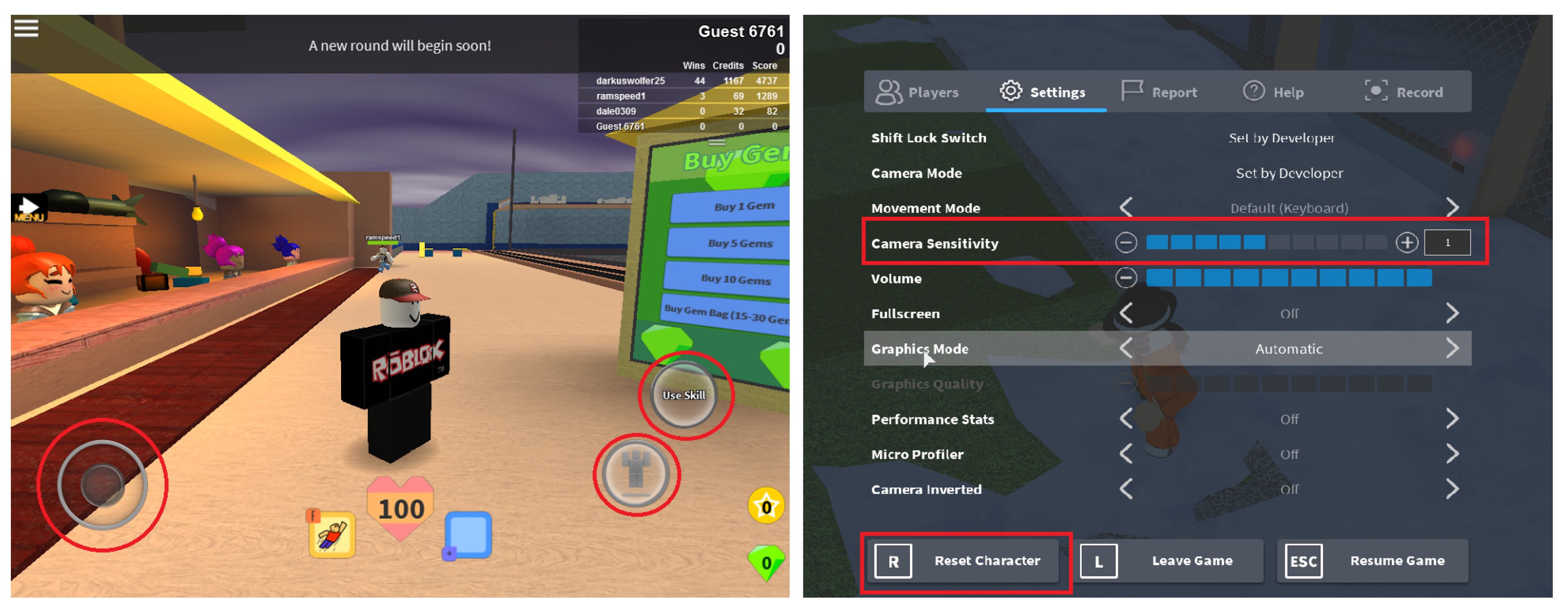
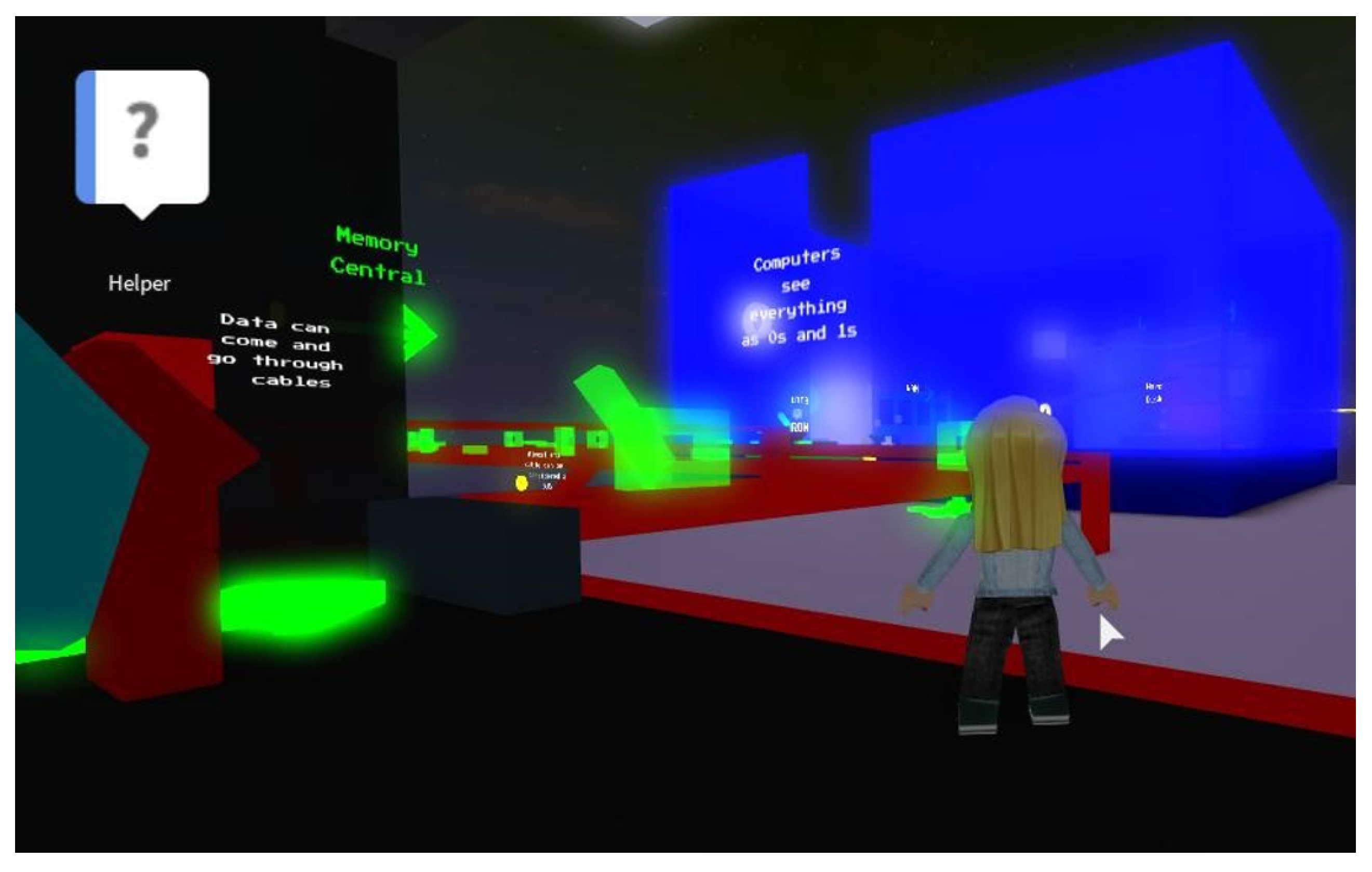
| Guideline | V | M | C | H |
|---|---|---|---|---|
| G1. Adequate distributed virtual controls | • | • | ||
| G2. Sensitivity sliders | • | |||
| G3. Controls compatible with assistive technology | • | |||
| G4. Adjustable sensitivity/error tolerance | • | • | • | • |
| G5. Use simple language | • | • | • | • |
| G6. Voice or text repetition | • | • | • | • |
| G7. Appropriate words-per-minute | • | |||
| G8. Subtitles | • | • | ||
| G9. Pause while text is being readed | • | • | • | • |
| G10. Save Points | • | |||
| G11. Use explicit visual rewards | • | • | • | |
| G12. No timing essential to gameplay | • | |||
| G13. Simple to difficult progression | • | • | • | • |
| G14. Visual indication of who is currently speaking | • | |||
| G15. Controls reminder during gameplay | • | |||
| G16. Simple Controls | • | • | ||
| G17. Challenges repetitions | • | • | • | • |
| G18. No multiple actions required | • | |||
| G19. No repetitive mechanics. | • | |||
| G20. Easy execution | • | |||
| G21. High Contrast | • |
| User | Session Start | Session Finish | Total |
|---|---|---|---|
| U1 | 11:55 | 12:34 | 0:39 |
| U2 | 15:45 | 16:35 | 0:50 |
| U3 | 17:41 | 18:00 | 0:19 |
| U4 | 19:00 | 19:16 | 0:16 |
| U5 | 19:00 | 19:20 | 0:20 |
| U6 | 20:50 | 21:15 | 0:25 |
| U7 | 22:13 | 22:30 | 0:17 |
| U8 | 21:10 | 21:32 | 0:22 |
| U9 | 22:24 | 23:15 | 0:51 |
| U10 | 22:37 | 23:00 | 0:23 |
Publisher’s Note: MDPI stays neutral with regard to jurisdictional claims in published maps and institutional affiliations. |
© 2020 by the authors. Licensee MDPI, Basel, Switzerland. This article is an open access article distributed under the terms and conditions of the Creative Commons Attribution (CC BY) license (http://creativecommons.org/licenses/by/4.0/).
Share and Cite
Jaramillo-Alcázar, A.; Cortez-Silva, P.; Galarza-Castillo, M.; Luján-Mora, S. A Method to Develop Accessible Online Serious Games for People with Disabilities: A Case Study. Sustainability 2020, 12, 9584. https://doi.org/10.3390/su12229584
Jaramillo-Alcázar A, Cortez-Silva P, Galarza-Castillo M, Luján-Mora S. A Method to Develop Accessible Online Serious Games for People with Disabilities: A Case Study. Sustainability. 2020; 12(22):9584. https://doi.org/10.3390/su12229584
Chicago/Turabian StyleJaramillo-Alcázar, Angel, Paz Cortez-Silva, Marco Galarza-Castillo, and Sergio Luján-Mora. 2020. "A Method to Develop Accessible Online Serious Games for People with Disabilities: A Case Study" Sustainability 12, no. 22: 9584. https://doi.org/10.3390/su12229584
APA StyleJaramillo-Alcázar, A., Cortez-Silva, P., Galarza-Castillo, M., & Luján-Mora, S. (2020). A Method to Develop Accessible Online Serious Games for People with Disabilities: A Case Study. Sustainability, 12(22), 9584. https://doi.org/10.3390/su12229584







